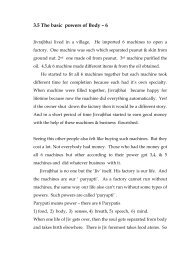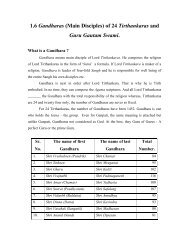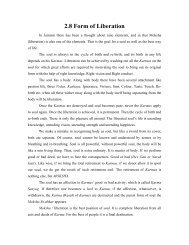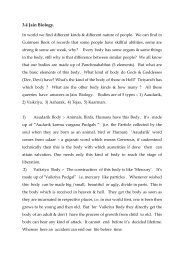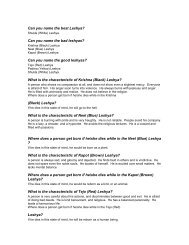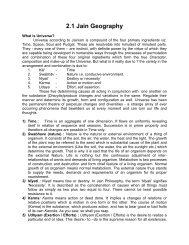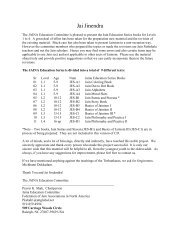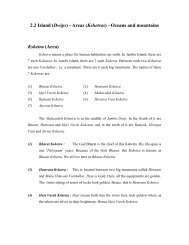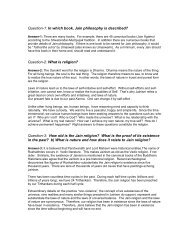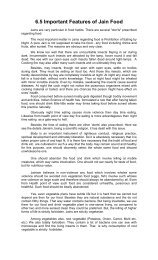âæ¢ ç¸ï¼¯ï¼ è£æ½® J - Jainism, Jain Religion - colleges
âæ¢ ç¸ï¼¯ï¼ è£æ½® J - Jainism, Jain Religion - colleges
âæ¢ ç¸ï¼¯ï¼ è£æ½® J - Jainism, Jain Religion - colleges
Create successful ePaper yourself
Turn your PDF publications into a flip-book with our unique Google optimized e-Paper software.
One-day prince Parshva was enjoying a view of the town from the balcony of his palace. When he saw groups of men and<br />
women, carrying items for worship, passing by, he asked out of curiosity if it was some day of religious ceremonies. His<br />
attendants informed him that some mendicant named Kamath is doing a harsh penance named Panchagni Tap (Five-fire<br />
penance). The citizens are going to pay homage to him with all these presents. Prince Parshva also proceeded to witness<br />
this strange scene. As he was endowed with three levels of knowledge since birth, Parshva perceived every thing worth<br />
knowing about this person at once. This was the same being that had been nurturing an intense feeling of vengeance for him<br />
for many births. After completing his age in the hell he was born in a poor family. Driven by hunger and poverty he had<br />
become a mendicant and was influencing the ignorant masses with his harsh but ill-conceived penance.<br />
When prince Parshva came near the mendicant he saw that some logs of wood were burning all around the mendicant.<br />
Inside one of the logs was a pair of serpents, writhing in pain due to the intense heat of the burning flames. Moved by a feeling<br />
of compassion the prince said to the mendicant, “Burning a five sensed being in fire, what sort of self improvement do you<br />
strive for?” The mendicant replied angrily, “Prince! You are a child; go and enjoy your princely games. It is mendicants like<br />
me who know about religion not you. How can you claim that some being is burning in the fire around me?” (P-3/1)<br />
„±üü ¿¢¢Ý¢² ½±¼é J<br />
All the efforts to persuade him that a pair of serpents was burning in the fire went in vain. Parshva then ordered his attendants<br />
to draw the specific log aside and split it. As soon as the attendants did that, a pair of serpents, partially scorched, fell on the<br />
ground writhing in pain. Realizing that they were about to die, prince Parshva said to them that they should not be annoyed<br />
with the ignorant mendicant and should remain equanimous during the last moments of their lives. He also recited the<br />
Namokar Mantra. As a result of equanimous thoughts and hearing the Namokar Mantra, after death the pair was born as the<br />
king and queen of the gods of the Nag Kumar clan (Dharanendra and Padmavati). (P-3/2)<br />
The mendicant became angry and kept on adding more fuel to the fire of vengeance. After death he reincarnated as the evil<br />
god Meghmali.<br />
This incident inspired Parshva Kumar to step on the right path and show the path to the masses misled by such ignorant<br />
hypocrites. While he was contemplating this, he one day went to a garden and changed to see some forces about the<br />
incidents of life of Bhagavan Arishtanemi. These vivid paintings pushed him to the decision of becoming an ascetic. He<br />
sought permission of his father and started the yearlong charity. On the eleventh day of the dark half of the month of Paush<br />
he became an ascetic under an Ashok tree.<br />
One day Parshva-muni was standing in meditation in Saushamb jungle. God Dharanendra arrived there to pay homage.<br />
When he saw scorching sunrays falling on the meditating ascetic, he covered Parshva-muni with a canopy of snake hoods.<br />
It is said that this area later became famous as Ahichhatra.<br />
One day Parshva-muni was standing in meditation under a banyan tree in an Ashram outside a village. The evil god Meghmali,<br />
the Kamath of earlier birth, through his evil powers became aware of this. Driven by the animosity of earlier births, Meghmali<br />
jainuniversity.org<br />
arrived at this pot where Parshva-muni was standing meditation. He took the form of a ghost and tried to disturb Parshvamuni<br />
with his extremely loud and fearsome laughter. When Parshva-muni remained unmoved, Meghmali inflicted pain on<br />
him by attacking in the form of various animals. Parshva-muni tolerated all these afflictions with equanimity. Meghmali’s<br />
anger reached its peak. (P-4/1)<br />
Now he created dark and dense clouds in the skys. The sky was completely covered by dark rain-bearing clouds. With<br />
fearsome rumbling and thunder and lightening it started raining heavily. Meghmali caused so much rain that it flooded the<br />
whole area. Parshva-muni tolerated the torment of this torrential rain Parshvanath’s nose. He was still unmoved in his<br />
meditation. At this peak of the affliction, the throne of god Dharanendra trembled. He came to know about the incident<br />
through his divine powers and reached the spot with Padmavati. One of these snake-gods created a platform under the feet<br />
of Parshva-muni and the other a canopy of its multiple hoods over his head. Dharanendra admonished Meghmali whom then<br />
fell at the feet of Parshva-muni and sought his forgiveness. (P-4/2)<br />
After eighty-three days of penance and spiritual practices Parshva-muni came to Ashrampad garden in Varanasi and stood in<br />
meditation under a Dhataki tree. With fast increasing purity he attained omniscience on the forth day of the dark half of the<br />
month of Chaitra. The gods created the divine pavilion. Bhagavan Parshvanath gave his first discourse on the form of<br />
religion. He propagated the four dimensional religion (Ahimsa, truth, non-stealing and non-possession) for upliftment of the<br />
soul.<br />
Inspired by the discourse of Bhagavan Parshvanath, many members of his family including his father Ashvasen, mother<br />
Vama Devi, and wife Prabhavati took Diksha from him. Many other princes and scholars including the famous Vedic scholar<br />
Shubhdatta also took Diksha after hearing to his discourse. Bhagavan Parshvanath established the four pronged religious<br />
organization. He had eight chief disciples with Shubhdatta being the first and most seniors.<br />
Although no detailed mention is available about the areas visited by Bhagavan Parshvanath, it can be surmised from various<br />
incidents and related stories that he covered a considerably wide area of the subcontinent. It appears that he visited Kashikaushal<br />
(Uttar Pradesh), Nepal, Bang (Bengal), Kalinga (Orissa), Anga (Magadh), Vidarbh, Konkan, Saurashtra etc. Among<br />
his followers were Shakya kings, rulers of Magadh (grandfather and father of king Shrenik) and many others.<br />
Amar Muni - Tirthankar Charitra - Surana # 27<br />
www.jainuniversity.org




